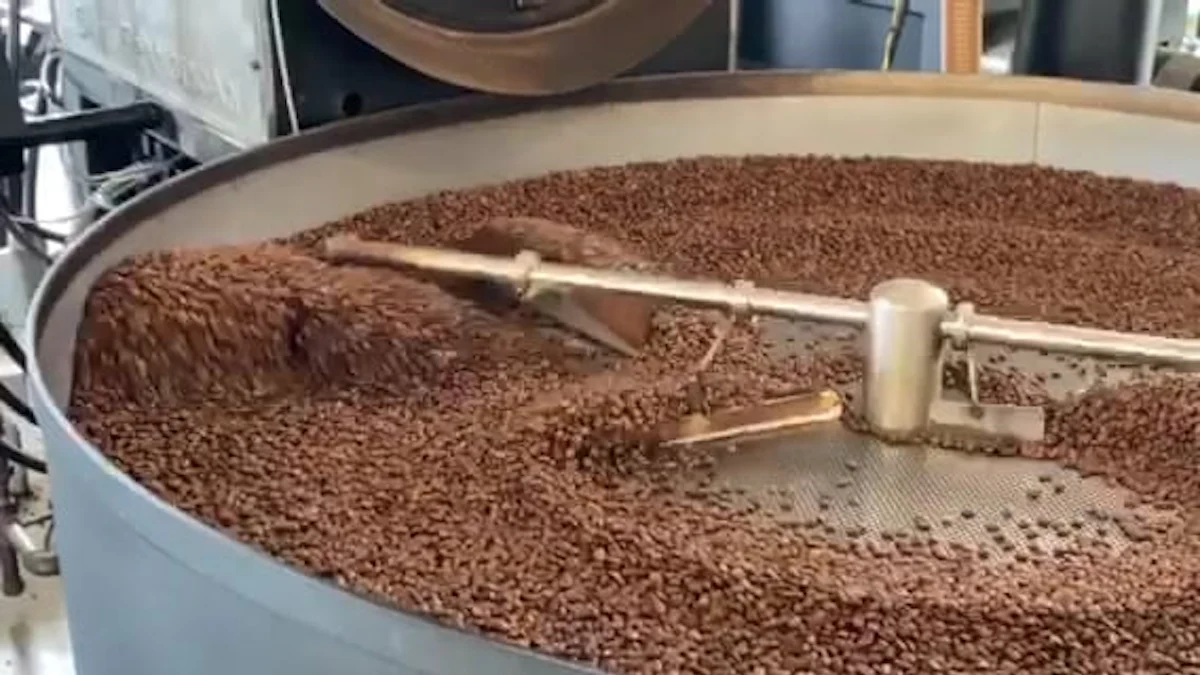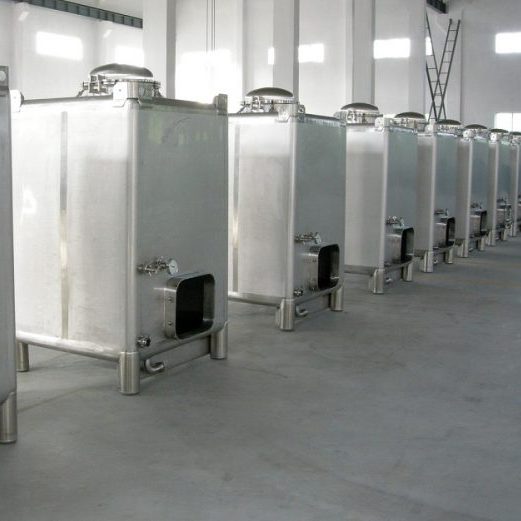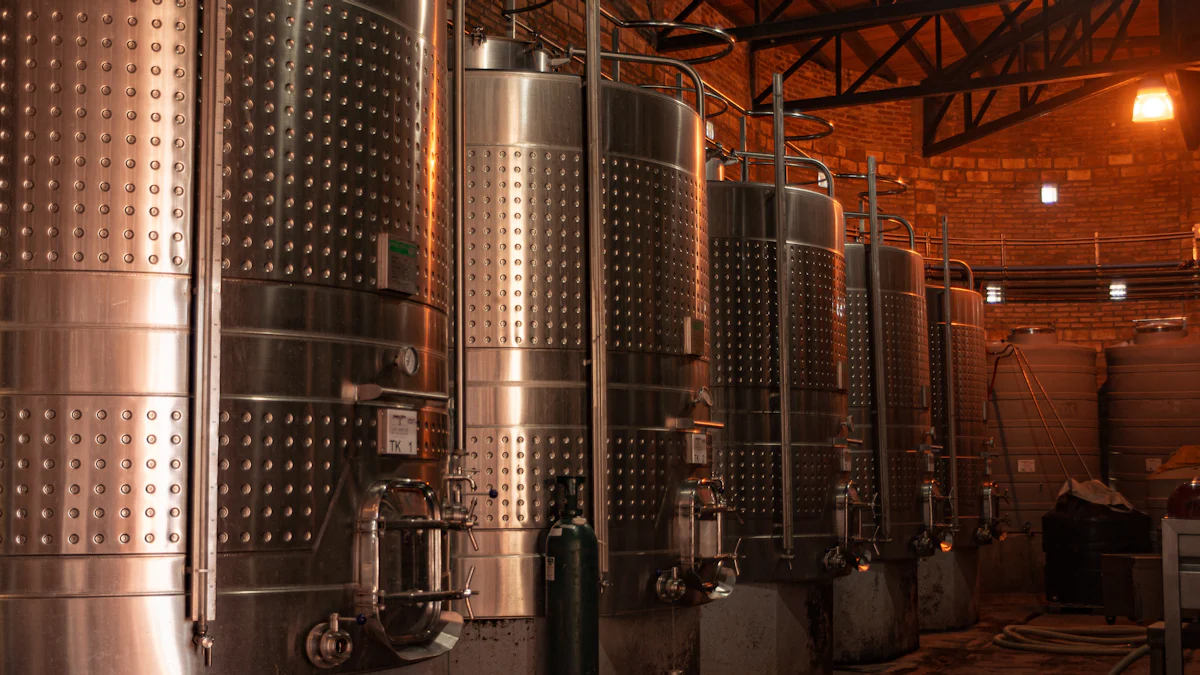
When fermenting wine in stainless steel tanks, the choice of vessel plays a crucial role in shaping the final product. Stainless steel tanks have become a staple in modern wineries worldwide, offering cost-effectiveness and the ability to preserve the wine’s original flavor. This trend began in the 1960s, driven by advancements in winemaking techniques. On the other hand, oak barrels remain a favorite for their ability to add tannins and complex flavors. Each option impacts not only the flavor profile but also the overall cost and maintenance requirements. Your decision depends on your winemaking goals and the style of wine you want to create.
Fermenting Wine in Stainless Steel Tanks: Key Advantages
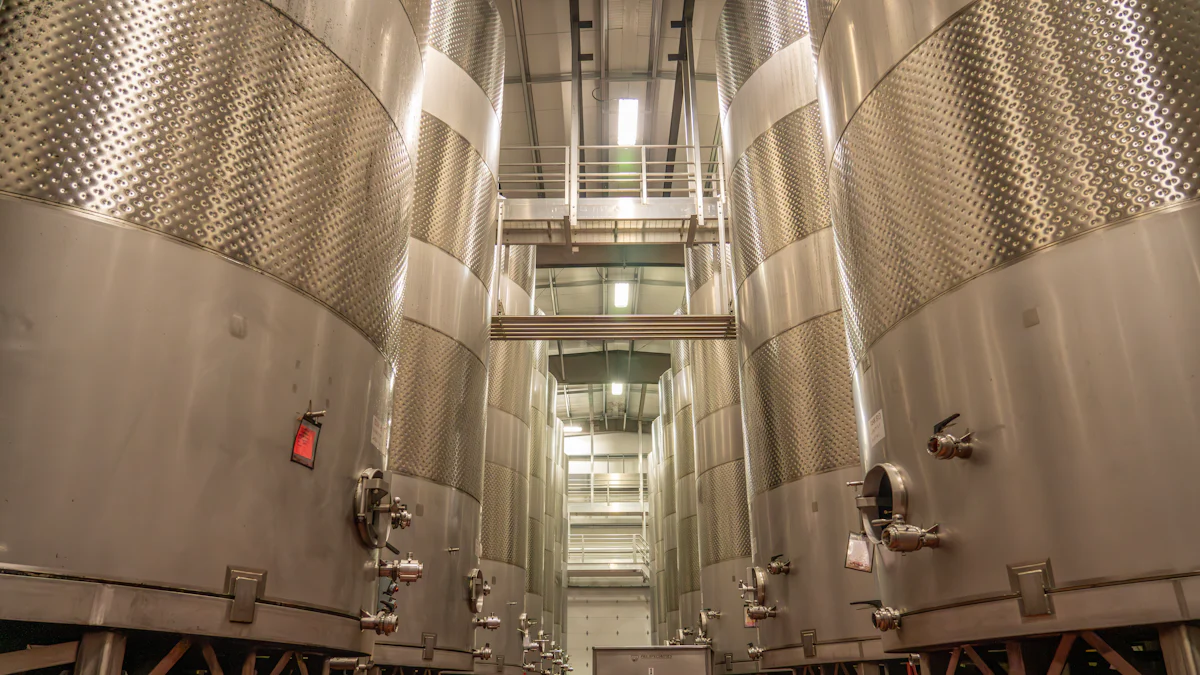
Neutrality and Flavor Preservation
When you choose stainless steel tanks for fermenting wine, you preserve the natural flavors of the grapes. These tanks do not impart any additional flavors or aromas to the wine. This neutrality allows the true characteristics of the grape variety to shine. For wines like Sauvignon Blanc or Riesling, where freshness and fruit-forward profiles are essential, stainless steel tanks are ideal. By avoiding external influences, you can create wines that are crisp, aromatic, and true to their origins.
Cost-Effectiveness and Durability
Stainless steel tanks offer significant cost advantages over oak barrels. Oak barrels are expensive and require replacement every few years, which increases long-term costs. In contrast, stainless steel tanks are durable and can last for decades with proper care. They also hold larger volumes, making them cost-effective for large-scale wine production. Additionally, oak-aged wines often come with higher price tags due to the added complexity and aging process. By using stainless steel tanks, you can produce high-quality wines while keeping production costs manageable.
Ease of Maintenance and Hygiene
Maintaining stainless steel tanks is straightforward. Their smooth surfaces make cleaning easy, reducing the risk of contamination. Unlike oak barrels, which can absorb wine and harbor bacteria, stainless steel tanks provide a hygienic environment. This ensures consistent wine quality and minimizes the chances of spoilage. For winemakers, this ease of maintenance translates to more efficient operations and better control over the fermentation process.
Temperature Control and Consistency
When fermenting wine in stainless steel tanks, you gain precise control over temperature. This feature is crucial during fermentation, as temperature fluctuations can significantly affect the wine’s flavor and quality. Stainless steel tanks allow you to maintain a stable environment, ensuring consistent results with every batch.
These tanks often come equipped with advanced temperature regulation systems. You can use built-in cooling jackets or external temperature control units to adjust the fermentation process as needed. This level of control helps you prevent overheating, which can kill yeast and halt fermentation prematurely. It also allows you to slow down fermentation when necessary, enhancing the development of delicate flavors and aromas.
The benefits of temperature control extend beyond wine production. Industries like beer brewing, dairy processing, and fruit juice production rely on stainless steel tanks for their ability to maintain precise temperatures. For example:
- Beer fermentation uses these tanks to prevent oxidation and contamination, preserving flavor and quality.
- Dairy processors use them to ensure hygienic conditions and accurate temperature control during yogurt fermentation.
- Fruit juice producers rely on them to maintain freshness and nutritional value while preventing oxidation.
In wine production, this same technology ensures that your wine retains its intended flavor profile. Whether you’re fermenting a crisp white wine or a robust red, stainless steel tanks provide the consistency you need to achieve your desired results. Their ability to regulate temperature also makes them ideal for aging wine, as they can control both temperature and humidity levels.
By choosing stainless steel tanks, you can create wines with precision and reliability. This makes them an excellent choice for winemakers who value consistency and quality in their craft.
Oak Barrels: Key Advantages
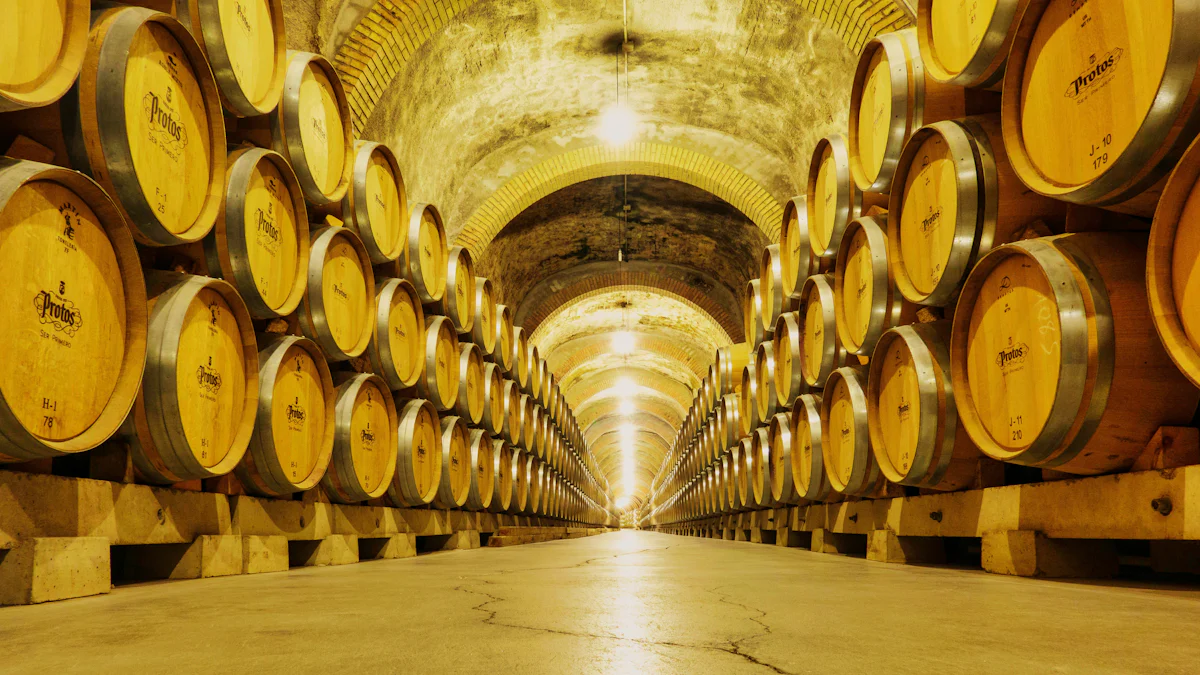
Flavor Enhancement and Complexity
Oak barrels bring a unique depth to wine by imparting complex flavors and aromas. As wine interacts with the oak, it absorbs compounds that enhance its profile. These include lignin derivatives, which add spicy notes and smoky undertones, and volatile phenols, which contribute hints of clove and spice. Whiskey lactones from the oak introduce woody and coconut flavors, while tannins provide structure and antioxidant benefits.
The aging process in oak barrels also develops flavors like vanilla, caramel, and sometimes coconut or dill. These elements combine to create a wine with a richer mouthfeel and a more rounded texture. The micro-oxidation that occurs through the porous oak softens tannins and integrates flavors, resulting in a smoother, more balanced wine. This complexity makes oak barrels a preferred choice for winemakers aiming to craft full-bodied wines with layered aromas and a luxurious finish.
Oxygenation and Aging Benefits
Oak barrels allow small amounts of oxygen to interact with the wine during fermentation and aging. This controlled oxygenation softens harsh tannins and enhances the wine’s overall harmony. Over time, the wine develops a smoother texture and a more refined flavor profile. The slow oxygen exchange also stabilizes the color of red wines, making them appear more vibrant and appealing.
This aging process is particularly beneficial for wines intended to mature over several years. The gradual integration of flavors and aromas creates a wine that evolves beautifully in the bottle. For winemakers, oak barrels offer a natural way to achieve complexity and elegance in their wines.
Traditional Appeal and Aesthetic Value
Oak barrels carry a timeless charm that resonates with both winemakers and consumers. Their use reflects centuries of winemaking tradition, adding an element of craftsmanship to the process. Many wine enthusiasts associate oak-aged wines with superior quality and luxury.
Consumer perception often links the level of oak influence to the wine’s quality. For example:
| Oak Influence | Preference in Market | Perception of Quality | |———————|———————————————–|———————————–| | High Oak | Favored among audiences seeking bold wines | Assumed to be superior | | Low to Moderate Oak | Preferred for balanced and subtle flavors | Considered high-quality | | No Oak | Sought after for pure fruit expression | Often seen as entry-level wines |
The visual appeal of oak barrels also enhances the winery experience. Rows of barrels in a cellar create an atmosphere of tradition and artistry, leaving a lasting impression on visitors. For winemakers, oak barrels not only serve as functional tools but also as symbols of their dedication to producing exceptional wines.
By choosing oak barrels, you embrace a fermentation vessel that combines flavor enhancement, aging benefits, and a connection to winemaking heritage. These qualities make oak barrels a compelling option for those seeking to craft wines with depth and character.
Comparing Stainless Steel Tanks and Oak Barrels
Flavor Impact on Wine
The choice between stainless steel tanks and oak barrels significantly affects the flavor profile of your wine. Stainless steel tanks preserve the wine’s original characteristics, resulting in a fresh and crisp taste. This method highlights the fruit-forward nature of the wine, making it ideal for varietals like Sauvignon Blanc or Pinot Grigio. In contrast, oak barrels enhance complexity by introducing flavors such as vanilla, caramel, and spices. These barrels also contribute a creamy texture and a more rounded mouthfeel.
| Method | Flavor Profile | Characteristics | |——————-|————————-|———————————————————————————| | Stainless Steel | Fruit-forward, fresh | Neutral aging, allows grape varietal expression, maintains terroir | | Oak Barrels | Complex, creamy texture | Adds aromas like vanilla, caramel, and spices, allows for oxygenation benefits |
Wines fermented in stainless steel tanks maintain a simpler profile, emphasizing the purity of the grape. On the other hand, oak barrels create depth and richness, making them a preferred choice for full-bodied wines. Your decision should align with the style of wine you aim to produce.
Cost Analysis and Long-Term Investment
When evaluating costs, stainless steel tanks offer a clear advantage. These tanks are durable and can last for decades with proper care. Although the initial investment may seem high, their longevity makes them a cost-effective choice for large-scale production. Oak barrels, however, require replacement every few years, which increases long-term expenses. The cost of acquiring and maintaining oak barrels also contributes to higher wine prices.
If you aim to produce high-quality wines while managing costs, stainless steel tanks provide a practical solution. They allow you to focus on efficiency without compromising the wine’s quality. Oak barrels, while more expensive, justify their cost by adding complexity and value to premium wines.
Maintenance and Durability
Stainless steel tanks excel in maintenance and durability. Their smooth surfaces make cleaning easy, reducing the risk of contamination. This hygienic environment ensures consistent wine quality and simplifies your operations. Oak barrels, in contrast, demand more attention. They require careful management to prevent spoilage and maintain flavor profiles. The porous nature of oak can harbor bacteria, making cleaning more labor-intensive.
For large-scale production, stainless steel tanks save time and effort. Their durability also means fewer replacements, making them a reliable choice for long-term use. Oak barrels, while less durable, remain valuable for their ability to enhance wine complexity. Your choice depends on your production scale and the level of maintenance you are prepared to handle.
Suitability for Different Wine Styles
Choosing the right fermentation vessel depends on the wine style you want to create. Stainless steel tanks and oak barrels each offer unique benefits that suit specific types of wine.
Stainless steel tanks work best for wines that emphasize freshness and fruit-forward characteristics. These tanks preserve the natural flavors of the grapes without adding external influences. You’ll find them ideal for producing crisp white wines like Sauvignon Blanc, Riesling, and Pinot Grigio. Stainless steel’s neutral nature helps retain fresh fruit aromas and flavors, making it perfect for light-bodied wines. Winemakers who prefer this method believe it allows the grape varietal to shine, creating wines that are vibrant yet uncomplicated.
Oak barrels, on the other hand, enhance complexity and depth. They suit wines where flavor development and structure are priorities. Red wines like Cabernet Sauvignon, Merlot, and Syrah benefit from the tannins and subtle notes of vanilla, spice, and caramel that oak imparts. Full-bodied white wines, such as Chardonnay, also thrive in oak barrels, gaining a creamy texture and layered aromas. The oxygen exchange through the oak’s porous surface softens tannins and integrates flavors, resulting in a smoother, more balanced wine.
Tip: The choice between stainless steel and oak isn’t about which is better. It’s about matching the vessel to the wine style and consumer preferences.
Here’s a quick comparison to guide your decision:
- Stainless Steel Tanks: Best for fresh, fruit-driven wines with crisp acidity.
- Oak Barrels: Ideal for complex, full-bodied wines with rich textures and layered flavors.
By aligning your fermentation vessel with your desired wine style, you can craft wines that meet your vision and delight your audience.
Factors to Consider When Choosing a Fermentation Vessel
Wine Style and Grape Variety
Your choice of fermentation vessel should align with the wine style you aim to produce and the grape variety you are working with. Different grape varieties respond uniquely to stainless steel tanks and oak barrels.
- Oak barrels enhance complexity by adding flavors like vanilla and spice. They also allow oxygenation, which softens the wine and adds structure through tannins.
- Stainless steel tanks retain the original personality of the wine. This neutral approach is ideal for fresh, fruit-forward wines, especially white varietals like Sauvignon Blanc or Riesling.
For white wines, stainless steel tanks preserve crisp acidity and vibrant fruit flavors. This makes them perfect for light-bodied wines that emphasize freshness. On the other hand, oak barrels suit full-bodied reds like Cabernet Sauvignon or Syrah. These wines benefit from the depth and texture that oak imparts.
Tip: Match your vessel to the wine’s intended style. Use stainless steel for clean, aromatic wines and oak barrels for wines requiring complexity and aging potential.
Budget and Long-Term Costs
Budget plays a critical role in your decision. Oak barrels represent a significant investment. Each barrel can cost up to $2,000 and requires replacement every two to three years. This adds to long-term expenses, especially for wineries producing large volumes.
Stainless steel tanks, while initially expensive, offer cost savings over time. They last for decades with minimal maintenance. This durability makes them a practical choice for wineries focused on efficiency. Additionally, wines aged in oak barrels often carry higher price tags due to the added complexity, which may influence your pricing strategy.
- Oak Barrels: High upfront and maintenance costs; ideal for premium wines.
- Stainless Steel Tanks: Cost-effective, durable, and suitable for large-scale production.
By evaluating your budget and production goals, you can determine which option aligns with your financial plan.
Winemaker’s Vision and Goals
Your vision as a winemaker should guide your choice. If you aim to craft wines with rich complexity and layered flavors, oak barrels provide the tools to achieve this. They allow oxygen exchange and impart unique aromas and textures.
If your goal is to highlight the natural fruit flavors of the grapes, stainless steel tanks are the better option. They offer precise temperature control, ensuring consistency and quality. For those seeking a balance, concrete vessels provide a middle ground, combining the benefits of both oak and stainless steel.
Ultimately, your fermentation vessel should reflect your winemaking philosophy. Whether you prioritize tradition, innovation, or a blend of both, the right choice will help you bring your vision to life.
Hybrid Approaches: Combining Stainless Steel and Oak
Benefits of Using Both Vessels
Combining stainless steel tanks and oak barrels allows you to enjoy the best of both worlds in winemaking. Each vessel offers unique benefits that complement one another, creating a balanced and versatile approach.
- Stainless steel preserves the wine’s fruit purity and freshness.
- Oak barrels add complexity with flavors like vanilla, spice, and caramel.
- Controlled oxygenation in oak softens tannins and enhances texture.
- Oak barrels also facilitate malolactic fermentation, which adds a creamy mouthfeel.
By using both vessels, you can craft wines that highlight the natural characteristics of the grapes while introducing layers of depth and structure. For example, fermenting wine in stainless steel ensures a clean and crisp base. Aging it in oak barrels afterward adds richness and smoothness. This method creates a wine that is both vibrant and complex, appealing to a wide range of palates.
Tip: Hybrid approaches allow you to tailor the winemaking process to your vision. You can experiment with different combinations to achieve the perfect balance of freshness and complexity.
Examples of Hybrid Winemaking Techniques
Winemakers use several techniques to combine stainless steel and oak effectively. One common method involves fermenting the wine in stainless steel tanks to preserve its bright, fruity flavors. After fermentation, the wine is transferred to oak barrels for aging. This process introduces subtle oak influences without overpowering the wine’s natural profile.
Another approach involves blending. Some winemakers ferment a portion of the wine in stainless steel and the rest in oak barrels. Afterward, they blend the two to create a harmonious final product. This technique allows you to control the intensity of oak flavors and achieve a balanced result.
Partial oak aging is another popular method. In this case, winemakers age only a fraction of the wine in oak barrels while keeping the rest in stainless steel. This approach adds just a hint of oak complexity, making it ideal for lighter wines.
By combining these vessels, you can explore endless possibilities in winemaking. Hybrid techniques give you the flexibility to craft wines that stand out in both flavor and style.
Trends in Fermenting Wine in Stainless Steel Tanks
Innovations in Stainless Steel Technology
Advancements in stainless steel technology have transformed winemaking. Modern stainless steel tanks now feature cutting-edge designs that enhance efficiency and precision. For example, many tanks include built-in cooling jackets. These allow you to control fermentation temperatures with remarkable accuracy. This innovation ensures consistent results, even for delicate wines.
Some tanks also incorporate automated systems. These systems monitor and adjust temperature, pressure, and oxygen levels in real time. This level of control helps you maintain the wine’s quality throughout fermentation. Additionally, new surface treatments for stainless steel reduce the risk of contamination. These treatments create ultra-smooth interiors that are easier to clean and sanitize.
Another exciting development is the use of modular tanks. These tanks allow you to customize their size and configuration. This flexibility makes them suitable for both small-batch and large-scale production. By adopting these innovations, you can improve efficiency and produce wines that meet your exact standards.
Eco-Friendly and Sustainable Practices
Stainless steel tanks support eco-friendly winemaking practices. Their durability reduces waste because they last for decades without needing replacement. Unlike oak barrels, which require harvesting trees, stainless steel production has a lower environmental impact over time.
Energy-efficient designs also make these tanks more sustainable. Many modern tanks use insulation to minimize energy consumption during temperature regulation. This feature helps you reduce your winery’s carbon footprint.
Recyclability is another key advantage. At the end of their lifespan, stainless steel tanks can be recycled into new products. This process conserves resources and aligns with sustainable business practices.
Water conservation is also easier with stainless steel. Their smooth surfaces require less water for cleaning compared to porous materials like oak. This efficiency helps you save water while maintaining hygiene.
By choosing stainless steel tanks, you contribute to a more sustainable winemaking industry. These tanks not only improve your operations but also support environmental stewardship.
The Role of Chenma in Stainless Steel Tank Manufacturing
Expertise in Custom Stainless Steel Tanks
Chenma stands out as a leader in manufacturing custom stainless steel tanks for the alcohol and food and beverage industries. You benefit from their ability to tailor tanks to your specific needs, ensuring optimal performance for your winemaking process. Their expertise includes:
- Designing, engineering, and fabricating tanks that meet unique customer requirements.
- Operating a 20,000 m² production facility with over 200 skilled professionals.
- Using state-of-the-art machinery to create even the most technically demanding designs.
- Providing on-site assembly assistance and consultation for equipment placement.
- Offering follow-up support to address any concerns during setup or operation.
This level of customization ensures that your fermentation vessels align perfectly with your production goals, whether you’re crafting small-batch wines or scaling up for larger operations.
Quality Standards and Certifications
Chenma’s commitment to quality ensures that every tank meets the highest industry standards. You can trust their products to deliver reliability and safety. The company adheres to stringent quality control measures and holds multiple certifications:
| Certification Type | Year | |———————————————|————| | ISO9001-2005 Quality System Certification | 2005 | | ISO14001-2015 Environmental Management | 2015 | | OHSAS18001-2007 Occupational Health | 2007 | | EU CE Certification | N/A |
These certifications reflect Chenma’s dedication to producing tanks that meet global safety, environmental, and occupational health standards. By choosing Chenma, you ensure that your equipment complies with rigorous quality benchmarks, giving you peace of mind throughout the winemaking process.
Supporting Winemakers with Turnkey Solutions
Chenma simplifies the complexities of winemaking by offering comprehensive turnkey solutions. You receive end-to-end support tailored to your specific needs. Their services include:
- Process design to optimize your production workflow.
- Equipment manufacturing with precision and attention to detail.
- Installation and commissioning to ensure seamless integration.
- Technical training to empower your team with the knowledge to operate the equipment effectively.
“Describe your unique situation and let us take care of the rest. You will receive a permanent, turn-key solution. Processing is challenging work. We’re here to make it easier – that’s why we offer life-long support to all of our partners.”
With Chenma, you gain a partner dedicated to your success. Their turnkey approach allows you to focus on crafting exceptional wines while they handle the technical aspects of your operation.
Choosing between stainless steel tanks and oak barrels depends on your winemaking goals and the style of wine you want to create. Each vessel offers unique advantages:
- Oak barrels add complexity with flavors like vanilla and spice, soften the wine through oxygenation, and enhance texture with tannins. However, they come with higher costs and limited reuse.
- Stainless steel tanks preserve the wine’s original characteristics, offer durability with indefinite reuse, and provide cost-effective solutions for large-scale production.
For fresh, aromatic wines, stainless steel tanks are ideal. For complex, aged wines, oak barrels deliver unmatched depth. A hybrid approach combines the best of both, offering balance and versatility. Align your choice with your vision to craft exceptional wines.
FAQ
What is the main difference between stainless steel tanks and oak barrels for wine fermentation?
Stainless steel tanks preserve the wine’s natural flavors, while oak barrels add complexity with flavors like vanilla and spice. Stainless steel suits fresh, fruit-forward wines. Oak barrels work best for wines requiring depth and aging.
Can you combine stainless steel tanks and oak barrels in winemaking?
Yes, you can. Many winemakers ferment in stainless steel to retain freshness, then age in oak barrels for added complexity. This hybrid approach balances fruit purity with rich, layered flavors.
How do stainless steel tanks support sustainable winemaking?
Stainless steel tanks last for decades, reducing waste. Their smooth surfaces require less water for cleaning. They are also recyclable, making them an eco-friendly choice for wine brewing equipment.
Which wines are best suited for stainless steel fermentation?
Stainless steel fermentation works best for light-bodied, aromatic wines like Sauvignon Blanc, Riesling, and Pinot Grigio. These tanks maintain crisp acidity and vibrant fruit flavors.
Why do oak barrels enhance wine complexity?
Oak barrels allow oxygenation and impart compounds like tannins, lignin, and lactones. These elements add structure and flavors such as vanilla, caramel, and spice, creating a smoother, more balanced wine.


